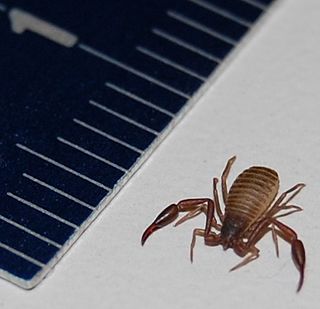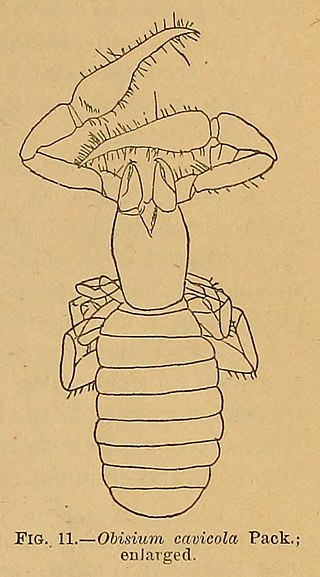
Pseudoscorpions, also known as false scorpions or book scorpions, are small, scorpion-like arachnids belonging to the order Pseudoscorpiones, also known as Pseudoscorpionida or Chelonethida.

Joseph Conrad Chamberlin was an American arachnologist who studied mainly pseudoscorpions. A native of Utah, he studied primarily at Stanford University while working most of his career in Oregon for the U.S. Department of Agriculture. Several species are named in his honor.
Ditha is a genus of pseudoscorpions in the family Chthoniidae. There are about 14 described species in Ditha.
Tridenchthonius is a genus of pseudoscorpions in the family Chthoniidae. There are about 16 described species in Tridenchthonius.

Chernetidae is a family of pseudoscorpions, first described by Anton Menge in 1855.

Olpiidae is a family of pseudoscorpions in the superfamily Garypoidea. It contains the following genera:

Garypinidae is a family of pseudoscorpions, first described by Eugen von Daday in 1889.
Dinocheirus is a genus of pseudoscorpions in the family Chernetidae.
Synsphyronus is a genus of pseudoscorpions in the Garypidae family. It was described in 1930 by American arachnologist Joseph Conrad Chamberlin. Its distribution is mainly in Australia, but also extends to New Zealand and New Caledonia.

Garypus is a genus of pseudoscorpions in the family Garypidae. It was described by German arachnologist Ludwig Carl Christian Koch in 1873. The species are found mainly in tropical and subtropical areas, where they occupy supralittoral and littoral zones in seashore habitats.

Cheliferidae is a family of pseudoscorpions in the order Pseudoscorpiones, first described by Antoine Risso in 1827.
Syarinus is a genus of pseudoscorpions in the family Syarinidae. There are about six described species in Syarinus.

Chitrella is a genus of pseudoscorpions in the family of Syarinidae.
Microcreagris is a genus of pseudoscorpions in the family Neobisiidae. It contains the following species:
Austrochthonius is a genus of pseudoscorpions in the family Chthoniidae. It was described in 1929 by American arachnologist Joseph Conrad Chamberlin.
Lagynochthonius is a genus of pseudoscorpions in the family Chthoniidae. It was described in 1951 by Austrian arachnologist Max Beier.

Tyrannochthonius is a genus of pseudoscorpions in the family Chthoniidae. It was described in 1929 by American arachnologist Joseph Conrad Chamberlin.
Ideoblothrus is a genus of pseudoscorpions in the Syarinidae family. It was described in 1892 by Italian naturalist Luigi Balzan as a subgenus of Ideobisium.
Americhernes is a genus of pseudoscorpions in the Chernetidae family. It was described in 1976 by American arachnologist William Muchmore.
Paraliochthonius is a genus of pseudoscorpions in the Chthoniidae family. It was described in 1956 by Austrian arachnologist Max Beier.








